How-To Guides
How to Clean a Dishwasher to Reduce Dirt
AZparts Team
Updated on July 31, 2025
7 min read
If you've ever wondered how to clean a dishwasher the right way, you're not alone. Food debris, grease, and soap scum can quietly build up and affect your dishwasher’s performance. A proper deep clean can eliminate odors, improve efficiency, and help your appliance last longer. AZParts will guide you through each step with the right tools and expert-approved cleaning solutions to make the job easier and more effective.

1. Why Cleaning Your Dishwasher Matters
Even though your dishwasher’s duty is to clean, that doesn’t mean it stays clean itself. Over time, detergent residue, food particles, grease, and grime can build up inside. Especially in hidden areas like the dishwasher filter, dishwasher spray arms, and dishwasher door gasket. This buildup can cause unpleasant odors, reduce cleaning performance, and leave your dishes looking dull.
If neglected, it may even lead to mold growth and expensive repairs. Regular cleaning helps prevent these issues, keeping your dishwasher hygienic, running efficiently, and producing spotless results every time.
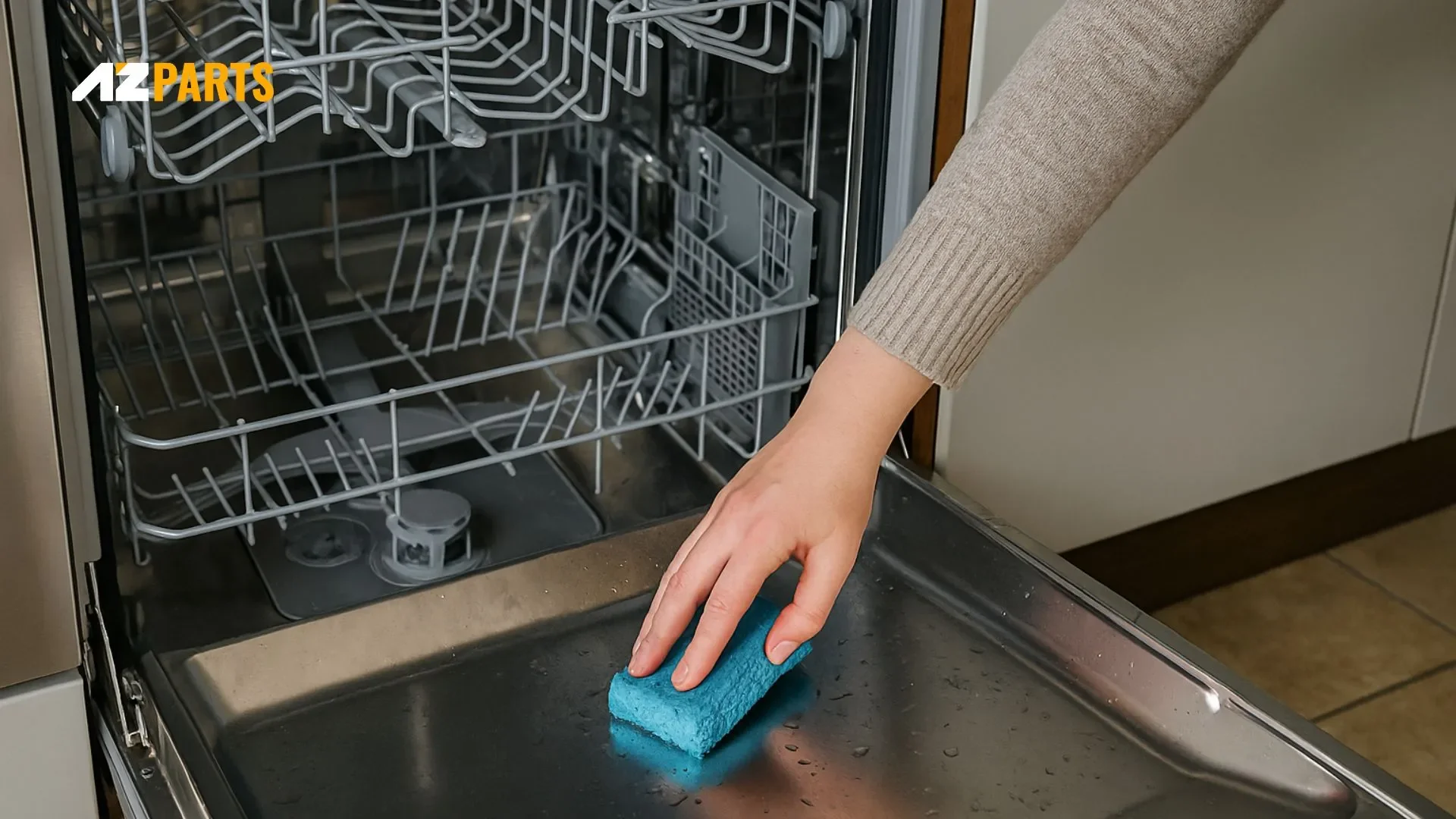
Wiping down the dishwasher interior with a sponge for a deep clean (Source: AZParts)
2. How Often Should You Clean Your Dishwasher?
The frequency of cleaning your dishwasher depends on how often you use it. If you run a load daily, a simple routine can help keep it fresh and running efficiently. Here’s a practical cleaning schedule to follow:
- Daily or After Every Load: Check and remove any visible food debris from the bottom of the dishwasher and around the filter area. This prevents clogging and keeps odors away.
- Weekly: Wipe down the door edges, door gasket, and detergent dispenser to remove grime or buildup. Take out the filter and rinse it under warm water to keep drainage smooth.
- Monthly: Run a deep cleaning cycle using vinegar, baking soda, or a dishwasher cleaner to remove grease, limescale, and lingering smells.
- As Needed: Clean the exterior and handle, and wipe away any stains or spots on the interior walls and racks.
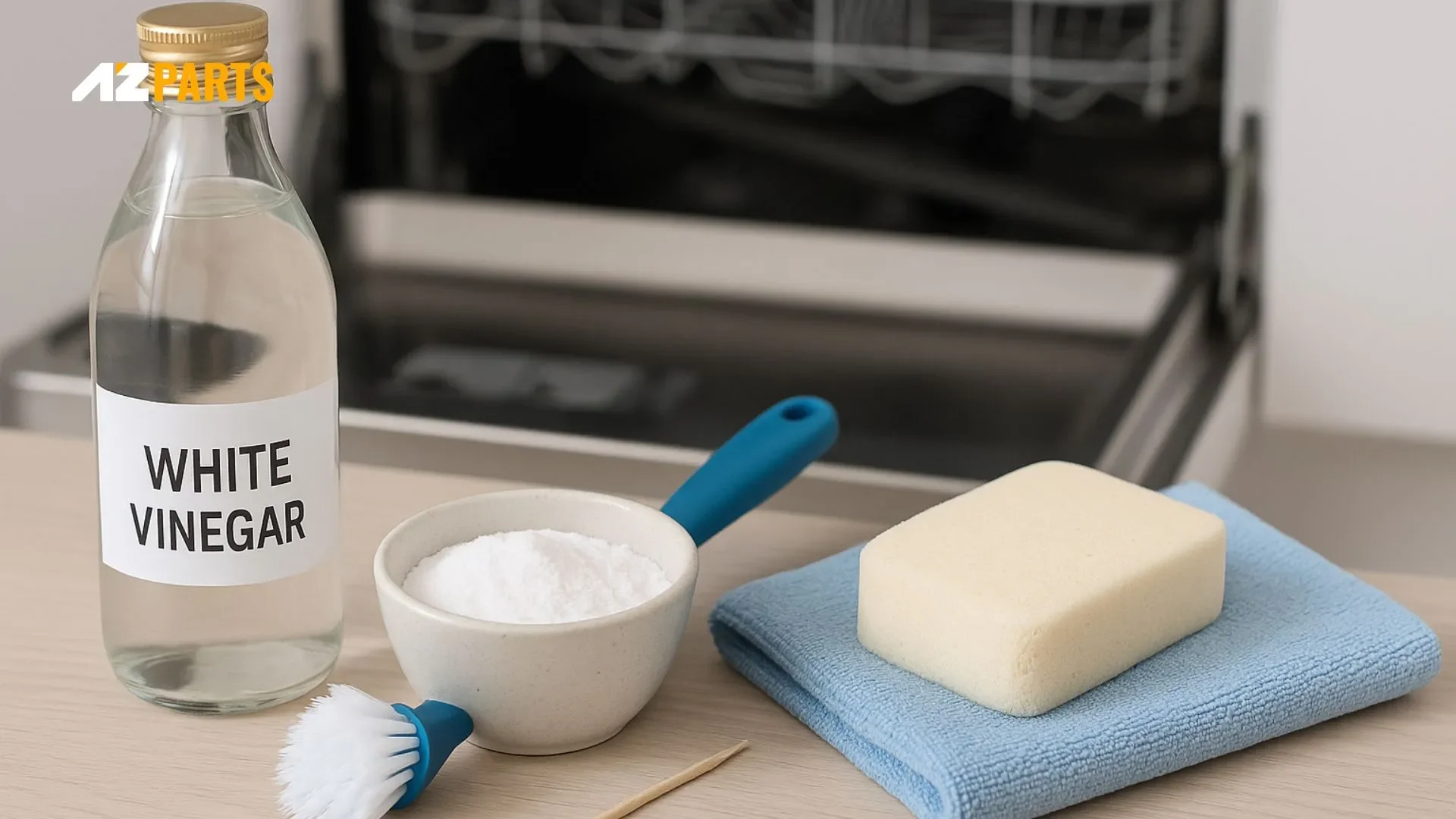
3. How to Clean Your Dishwasher with Vinegar and Baking Soda
A clean dishwasher means cleaner dishes. If your dishwasher smells musty or looks grimy, don’t worry—just grab some vinegar and baking soda. Here's how to give it a deep clean using items you probably already have at home.
Step 1: Clear the Filter
Start by removing any dishes. Then, check the filter at the bottom of your dishwasher. Clear out food scraps, debris, or foreign objects like popcorn kernels, paper bits, or glass. If your filter is removable, take it out and rinse thoroughly. (Refer to your user manual if you're unsure whether your model allows filter removal.)
Step 2: Run a Vinegar Cycle
Pour 2 cups (500 mL) of white vinegar into a dishwasher-safe container—like a glass measuring cup—and place it upright on the bottom rack. Run a normal wash cycle with heat dry turned off. Skip the detergent. This will help break down grease, odors, and mineral buildup inside your machine.
Step 3: Deodorize with Baking Soda
Once the vinegar cycle finishes, sprinkle 1 cup of baking soda across the bottom of the dishwasher. Run a short hot water cycle. This helps deodorize and brighten the interior, leaving your dishwasher sparkling clean and fresh-smelling.
Pro Tip: Use distilled white vinegar for best results—it’s free from coloring agents that might stain surfaces. You can also use diluted apple cider vinegar in a pinch.
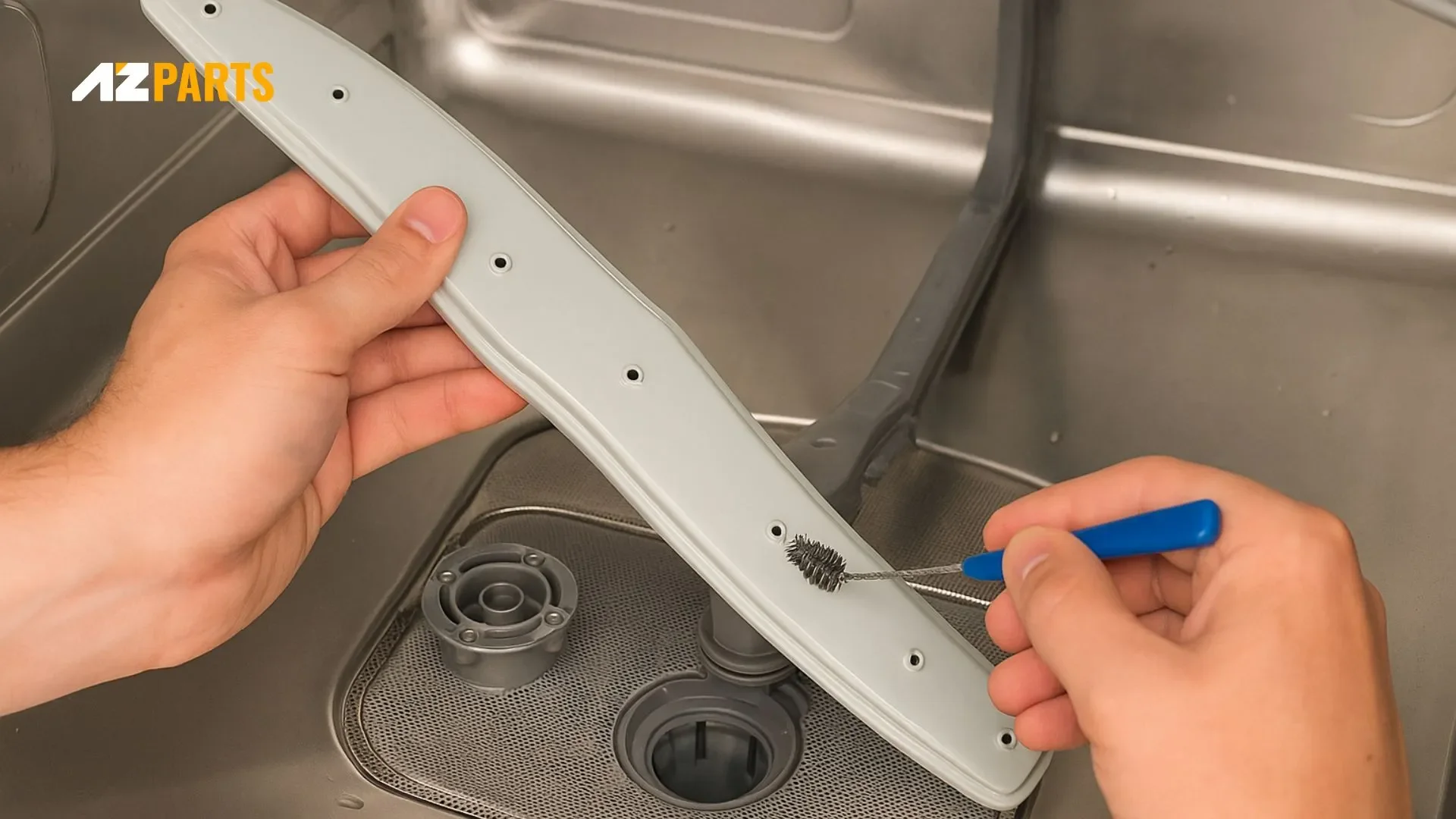
4. How to Sanitize a Dishwasher
Sanitizing your dishwasher goes a step beyond regular cleaning. It helps eliminate bacteria, mold, and lingering odors. Especially after washing heavily soiled dishes or during periods of high use. Here are two effective methods:
Option 1: With Vinegar
White vinegar is a safe and natural way to sanitize your dishwasher.
Steps:
- Make sure the dishwasher is completely empty.
- Place a dishwasher-safe cup filled with white vinegar on the top rack.
- Run a hot water cycle without detergent.
- Let the interior air dry with the door slightly open after the cycle.
Vinegar not only kills many common germs but also removes soap residue and mineral deposits without harming your appliance.
Option 2: With Bleach (Plastic Interiors Only)
Bleach is a powerful disinfectant, but it should only be used in dishwashers with plastic interiors. Never use bleach in stainless steel tubs, as it can cause corrosion.
Steps:
- Ensure the dishwasher is empty and that your machine has a plastic interior.
- Pour 1 cup of bleach into a dishwasher-safe bowl and place it on the top rack.
- Run a full hot water cycle without detergent.
Do not combine bleach with vinegar or other cleaners.
Bleach is highly effective at eliminating mold, mildew, and tough bacteria, but use it sparingly and with proper ventilation.
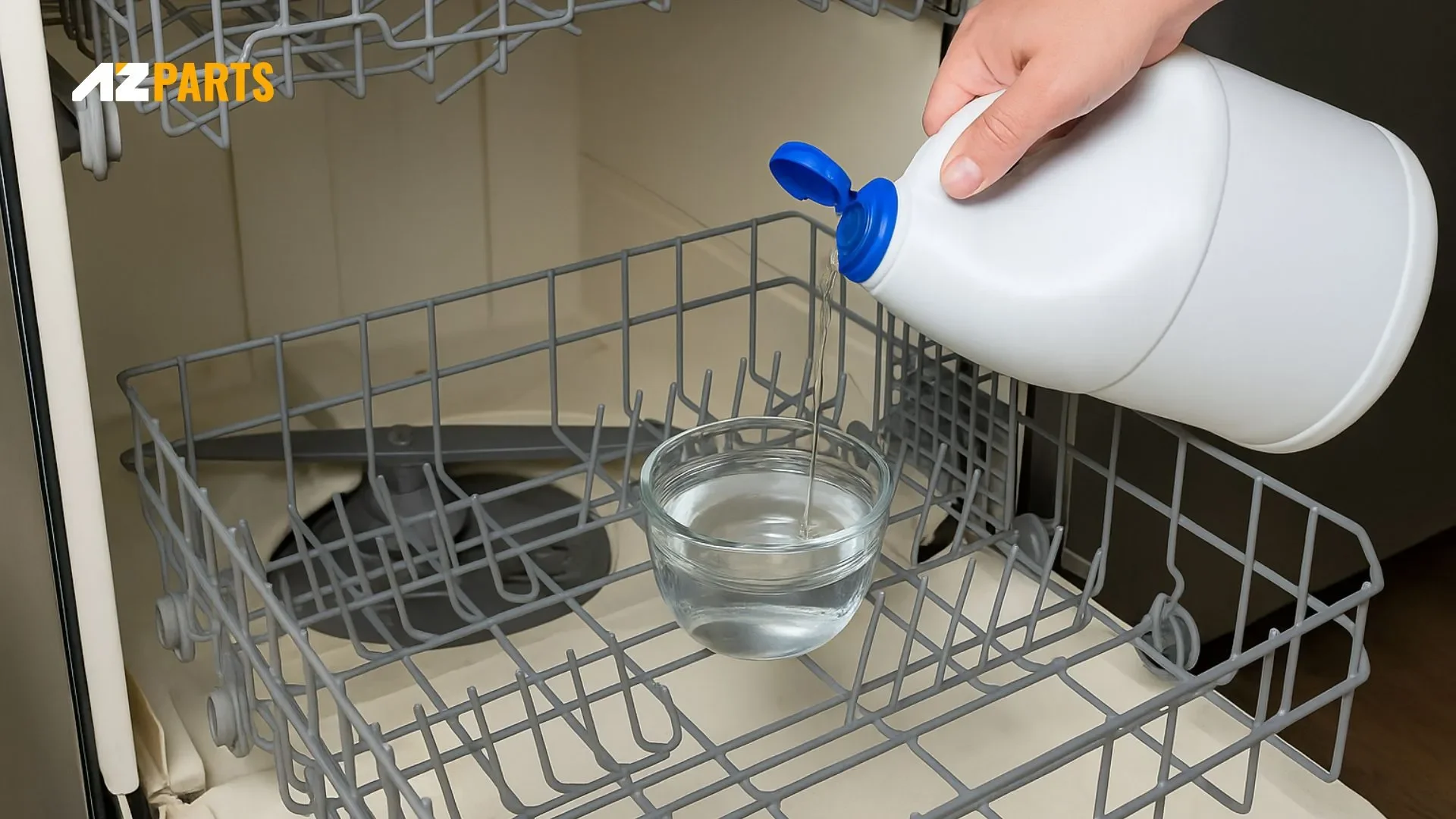
5. Tips to Keep Your Dishwasher Clean Longer
A few smart habits can help prevent grime, odors, and buildup from taking over your dishwasher. Here’s how to keep your machine clean and performing at its best with less effort over time:
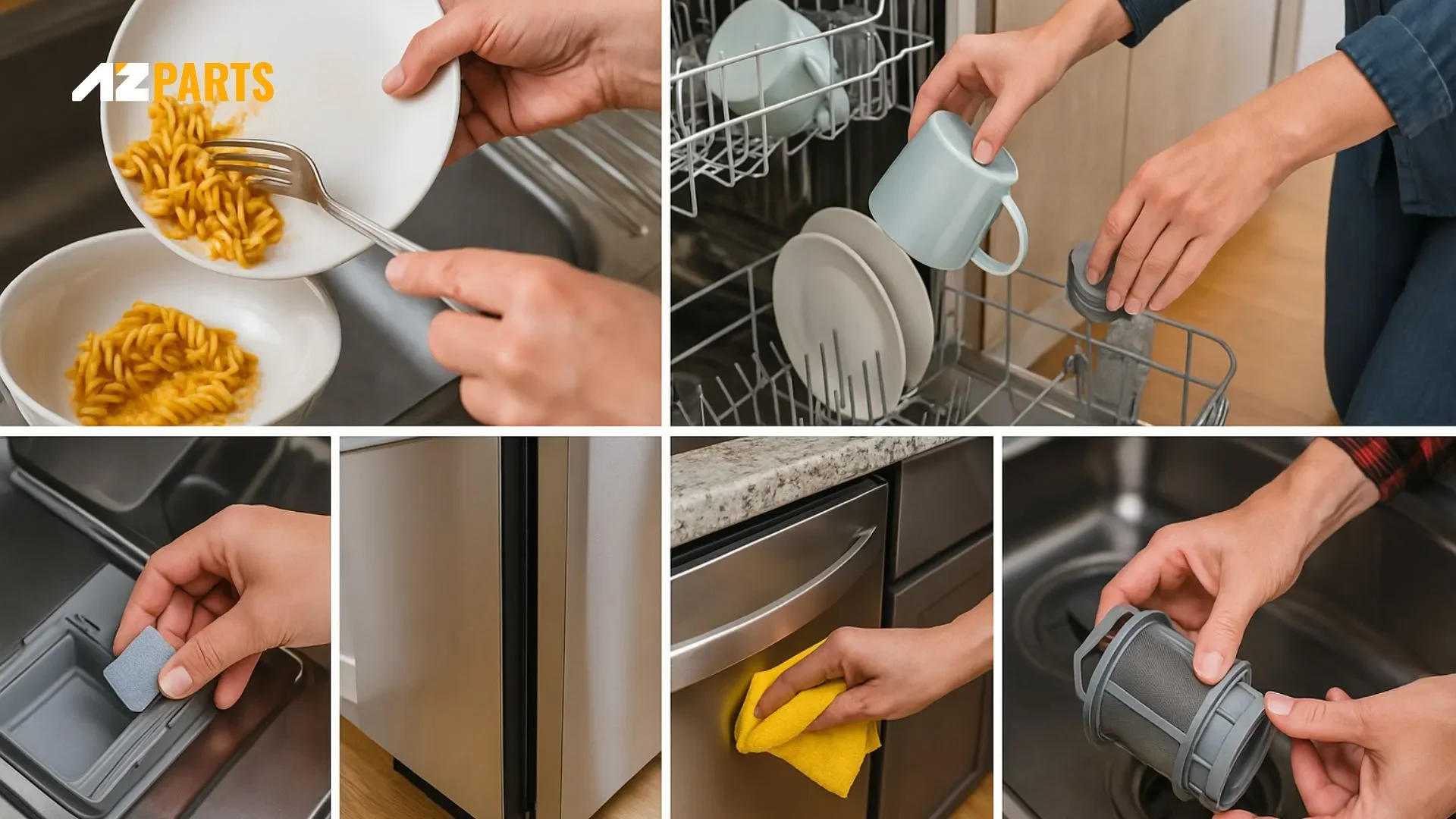
- Scrape off large food pieces before loading: This helps prevent filter clogs and keeps spray arms from getting blocked.
- Avoid washing items not labeled dishwasher-safe: Materials like wood, cast iron, or delicate china can warp, rust, or break down, which damages your dishes and your machine.
- Load dishes properly: Follow your manufacturer’s loading instructions to allow proper water flow and detergent distribution.
- Run your sink's garbage disposal first (if connected): This clears shared drain lines, reducing the chance of backflow or slow drainage.
- Use a cleaner or descaler monthly: A maintenance product like a dishwasher cleaning tablet can help prevent limescale, grease, and odor buildup.
- Keep the door ajar after each cycle. Allowing air to circulate prevents moisture from lingering inside, which helps stop mold and mildew growth.
- Wipe down interior surfaces weekly: A quick wipe of the door edges, seal, and controls can go a long way in keeping grime from building up.
- Check and rinse the filter regularly: Don’t wait until it smells; a quick rinse once a week keeps everything running smoothly.
Periodically inspect components like the dishwasher corner gasket, dishwasher rack wheels, and dishwasher arm mounts. Replacing worn parts and components can drastically improve longevity and performance.
Consistent maintenance takes only minutes but makes a huge difference in performance, cleanliness, and appliance lifespan. Your dishwasher will thank you with cleaner dishes and fewer surprises.
6. FAQs
6.1 Can I clean my dishwasher with vinegar and baking soda at the same time?
It’s best not to use them together in the same cycle. When mixed directly, vinegar and baking soda neutralize each other, reducing their individual cleaning power. For the best results, run a vinegar cycle first to break down grease and odors, then follow with a separate baking soda rinse to freshen and brighten the interior.
6.2 Can I use bleach in a stainless steel dishwasher?
No. You should never use bleach in a dishwasher with a stainless steel interior or stainless steel parts. Bleach can cause corrosion and permanent damage. If you need to sanitize a stainless steel dishwasher, use white vinegar or a dishwasher cleaner tablet that’s safe for metal finishes.
6.3 How often should I run a deep clean cycle?
A deep clean should be done once a month to maintain optimal performance. If you use your dishwasher frequently or notice odors, cloudy dishes, or food buildup, consider cleaning it more often. Regular maintenance helps prevent bigger issues down the line and keeps your machine running efficiently.
Understanding how to clean a dishwasher is key to keeping it running efficiently, smelling fresh, and producing spotless dishes. With just simple ingredients like vinegar, baking soda, and gentle brushes, you can maintain it easily and affordably at home. If you're in need of replacement parts, AZParts is a trusted source for high-quality, dishwasher-safe components. Regular maintenance and timely part replacements help prolong your appliance’s life and ensure consistently excellent performance.
Contact Info
Address: 8 The Green, Ste A, Dover, Delaware 19901-3618, United States
Email: support@azparts.com
Learn more cleaning tips for your dishwasher parts:
Dishwasher
Further Reading
Further Reading

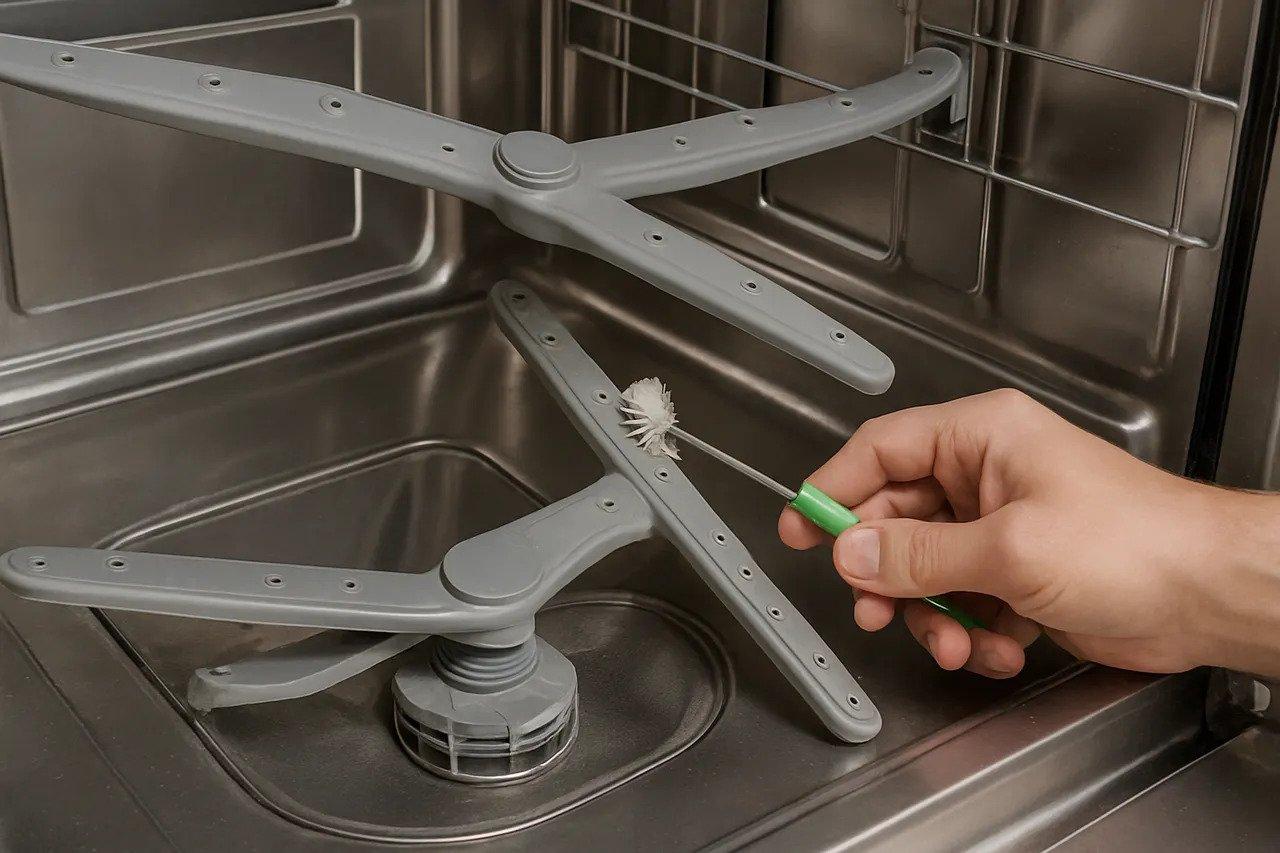

_1748246700.jpg&w=3840&q=75)

